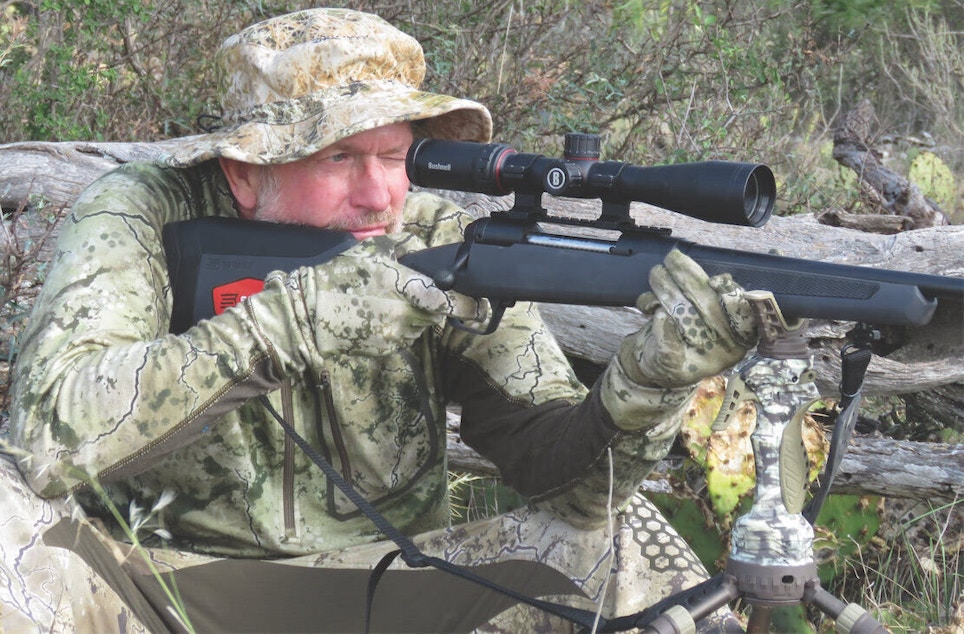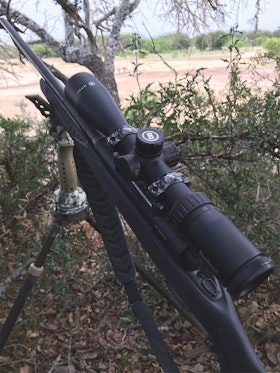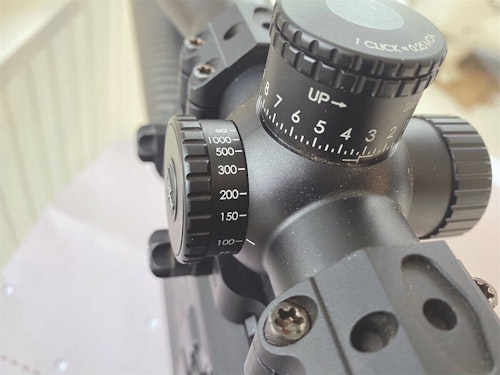Products that provide a high level of performance at a reasonable price are increasingly attractive. That’s a big reason why modern riflescopes in the middle of the pricing spectrum have become so popular.
As a lifelong shooter and hunter, I know that compromising on the design, construction and optical quality of a riflescope is a case of pennywise and pound foolish. I am also privileged to own a vintage Remington Model 30 chambered in .30-06 that was built back around 1930, a rifle willed to me by an old friend and mentor, George Effenberger, an entrepreneur who fought as a Marine Corps staff sergeant at the Chosin reservoir during the Korean War. Every now and then I like to take this rifle to the woods as a way to honor my friend.
I had a whitetail hunt scheduled for November 2020 in West Texas with Hargrove Hunts and wanted to replace the rifle’s ancient optic. I was looking for high quality at a working man’s price and selected a Trijicon Huron 3-9x40 with an old-school 1-inch tube and classic Duplex reticle, which was developed back in the 1960s. In addition to this model, 1-4x24, 2.5-10x40, and 3-12x40 versions are available, all with 30mm tubes. The Huron line is a great example of today’s mid-priced riflescope lines, optics that can be had for somewhere between $400-$750, and that are lightyears ahead of the top-end scopes of just a decade ago in terms of performance. It proved to be a wise selection.
History Lesson
The first true riflescope appeared for public consumption back in 1844, when competitive shooter Morgan James was profiled in the book, The Improved American Rifle, with the scope and mount system he had designed. Snipers used scope-sighted rifles from our Civil War through the two world wars, but up until the early 1950s, optical quality was pretty mediocre and mounting systems suspect. Until Roy Weatherby began producing his Mark V rifle in 1957 without iron sights, people thought it foolish to have a rifle with no backup sighting system “for when the scope failed.”
Today, of course, few sporting rifles outside MSRs and some lever and pump actions are built with iron sights. That’s because riflescopes have become so reliable that a failure is almost unheard of. My first scoped rifle was a pre-64 Model 70 Winchester chambered for .270 Win. It was topped with a Lyman Alaskan fixed-power 2.5X scope, with a thin crosshair and dot in the center of the reticle. My dad bought when he got out of the navy after WWII and killed some 50 southern California mule deer bucks with it. That was a state-of-the-art optic back then — but comparing it to the Huron is like comparing apples and oranges.
Progress in the optics industry moves at warp speed, for a host of reasons. The benefit for hunters and shooters is that today’s mid-priced scopes arguably give you similar performance and reliability found in scopes costing a whole lot more just a decade ago. Top-end scopes — those with huge tubes, oversized objective lenses, complex reticle systems, adjustable turret systems and price tags well over a grand — were inconceivable a generation ago, but for the average deer hunter, all those expensive bells and whistles really aren’t necessary for consistent success in the field.
Great Value
Like a lot of modern inventions, change starts out at a glacial pace, then increases rapidly as both technology and an understanding of the product evolve. This is as true in riflescope development as anything else.
Early scopes were of a single fixed power, with 4X soon becoming the most popular. Today, variable-power scopes rule because of their versatility. Though first developed in the 1950s, this technology did not become widely available on civilian optics until the 1990s. In the early 1970s, Don Burris of Redfield developed the first high-magnification scopes with internal adjustments. Weaver’s 1977 introduction of Micro-Trac adjustments — the first accurate internal windage and elevation adjustments — changed the game yet again. The point being, big changes occurred, but not quickly.
More rapid advancements can be traced in no small measure to computers, which speed up the work of optical designers building new lens systems (riflescopes have eight different lenses in most cases) and tweaking scope size, weight and adjustment capabilities. Computer design also keeps costs down.
Another key factor is designing riflescopes to wring out the performance capabilities of today’s rifles. Today, except for a few hardcore backcountry hunters, shooters do not look at rifle weight as a bad thing anymore. Heavier rifles are the love of long-range and tactical shooters, and that means their optics and their mounting systems can also be bigger and heavier. This gives scope designers a lot more options to play with. Today skilled shooters routinely clang gongs — and sometimes animals — and distances out to 1,000 yards or more, which has spurred the development of higher top-end magnification, larger objective lenses, range-compensating reticles, lighted reticles, turret systems that mate to a rifle/load’s specific ballistics and allow the shooter to hold dead on regardless of the distance, and oversized scope tubes. Standard 1-inch tubes have given way, in many cases, to larger 30mm tubes, which are stronger and allow more latitude of adjustment. You can also find larger tubes, and objective lenses as large as 56mm.
Improved out-of-the-box accuracy in moderately priced rifles and factory ammunition has helped push the top-end magnification of many modern scopes. Back in my early shooting days in the late 1960s, a three-shot, 100-yard group of 1 ½-inches was considered excellent; you had to handload to get a rifle to produce sub-MOA accuracy. Today, ½-inch MOA groups are not unusual using moderately-priced rifles and premium-type factory ammunition. To utilize this accuracy potential at extended distances, you need more magnification to be able to “aim small.” The old 3-9X variable has been replaced by scopes in the 3-12X, 4-14X, and 5-25X class, for example.
It should be noted that, in most big-game hunting situations, the hunter has the opportunity to take a solid rest before shooting. This may be on the rail of a tree stand, the edge of a shooting house window, sitting with a set of shooting sticks, or going prone, but in very few cases is shooting offhand without a rest advisable. The need for a solid rest is emphasized when using high-magnification scopes that not only magnify the target, but greatly magnify the wobble of trying to hold an unsupported rifle steady, and even your heartbeat.
Scope adjustment is critical, and again, improvements have made reliable windage and elevation adjustment commonplace in mid-priced scopes. The best windage and elevation adjustments move with a precise “click,” and adjust bullet placement precisely ¼-inch at 100 yards or one MOA, if that’s what the scope says it will do. You also have to be able to focus the reticle, which is easily done by aiming the scope at a clear sky or blank wall, then turning the ocular (rear) lens bell until the reticle appears sharp to your eye, then lock it in. On scopes designed for long-range shooting, parallax also must be adjusted. Simply stated, just as you need to focus a binocular for a specific distance, so too must the scope be focused to avoid the target to appear to be where it is not. Most scopes without a separate parallax adjustment turret — located at the 9 O’clock position on the scope, or sometimes on the objective lens bell — have been pre-focused at the factory at somewhere between 150 and 175 yards. The manufacturer assumes you’ll use these scopes for hunting deer-size game at moderate ranges. If you plan on shooting at targets at distances exceeding 400 yards, separate parallax adjustment is an important feature.
Retail Cost
Again, harkening back to “old days,” the rule of thumb when choosing a riflescope was 2:1 – spend $400 on a rifle, then spend $200 on the scope. Today, in most cases I think that’s reversed — spend $500 on the rifle, and maybe that much, or a tad more, on the optic and mounting system. While I have always been a bargain hunter, two items I have always believed in spending serious money on were my riflescopes and binoculars. The last thing you can afford is to have an optic failure after a season of rough and tumble field abuse, when the weather’s bad, the light dim, and that one opportunity in a long season presents itself.
“The Huron family of scopes was specifically developed with the deer hunter in mind,” says Trijicon Product Manager John Fink. “The magnification offerings provide options for all rifle types used in deer hunting. Whether it be lever guns, muzzleloaders, bolt actions, or autoloaders, there is an option in the Huron family to meet your customer’s needs. As is the standard with all Trijicon products, the Huron line is built with top-quality premium components with the reliability and durability to perform under the most demanding conditions, all backed with a solid warranty. And at an MSRP of $650 for the 1-4x24 model, and $699 for the 2.5-10x40, 3-12x40, and 3-9x40 models, they’re an excellent value on today’s market.”
The quality of mid-priced optics has gotten exceptional over the last 10 years. Unless a customer is strictly a brand loyalist, there’s no reason to spend hundreds — even thousands — of extra dollars to get a great scope,” says Mike Jensen, GPO USA’s owner and CEO.
“Every feature available in the market can be found in mid-priced products, including features like world-class illumination systems, endless options of ballistic reticles, turret features that 10 years ago were revolutionary, and optical performance so precise that the human eye cannot detect any abnormalities,” Jensen says. “It’s really an amazing industry development that provides huge benefits to the American sportsman.
“There are several models in the GPO riflescope lineup that are stretching optical boundaries and adding bonus features traditionally seen in more expensive brands,” Jensen continues. “For example, The GPO 3X PASSION 3-9x42 has a MSRP of just $399.99, and the base model riflescope is built with double-laminated HD objective front lenses. It’s optical transmission is excellent, and it includes finger-adjustable turrets and a fast focal ocular system. It also includes five additional ballistic turrets custom-made to work with Hornady American hunter ammunition. Turrets come for .223, .308, .30-06, 6.5 Creedmoor and .300 Win Mag. And the GPO 4X SPECTRA 2.5-10x44i, built on a 30mm tube with a MSRP of $699.99, is loaded with features that rival comparable European models priced two or three times higher. It has GPO’s signature Double HD laminated front objective lens system, a mil-based ballistic reticle that includes fiber optic microdot illumination for use in any light conditions, fast focus ocular, and finger adjustable reset turrets. Both are examples of the many great values available in the mid-priced category.”
Not-So-Scientific Test
When I returned from my successful West Texas hunt — I shot a dandy 6 ½-year old 8-pointer right at dusk — I did a little impromptu field testing. I brought out the old ’06 with the Huron on top, as well as several other rifles with various makes and models of scopes. Some scopes were 10 years old or more, some newer, some were uber-pricey top-end European brands, some were mid-priced American models from several manufacturers. Looking through them all at last light, to my aging eyes the brightness, sharpness, and clarity of the modern mid-priced scopes was on par with scopes costing twice as much purchased a decade ago.
Scientific proof? Hardly. What it does say, to me at least, is that if your customers are in the market to upgrade an old rifle’s sights, or looking to scope a new tack driver, steering towards mid-priced riflescopes with a quality mounting system is one way to make them happy.









